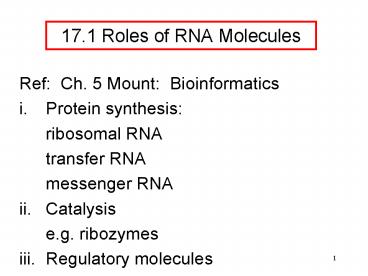17.1 Roles of RNA Molecules - PowerPoint PPT Presentation
1 / 28
Title:
17.1 Roles of RNA Molecules
Description:
Hydrophobicity. 17.2 Interactions of RNA Molecules. 3. Hydrophobicity. Self-complementary regions undergo complementary base pairing ... – PowerPoint PPT presentation
Number of Views:146
Avg rating:3.0/5.0
Title: 17.1 Roles of RNA Molecules
1
17.1 Roles of RNA Molecules
- Ref Ch. 5 Mount Bioinformatics
- Protein synthesis
- ribosomal RNA
- transfer RNA
- messenger RNA
- Catalysis
- e.g. ribozymes
- iii. Regulatory molecules
2
17.2 Interactions of RNA Molecules
- Nucleic acid interactions
- complementary base pairing
- Protein interactions
- Shape
- Charge
- Hydrophobicity
iii. Regulatory molecules
3
17.3 Shape of RNA Molecules
Self-complementary regions undergo complementary
base pairing - depends on the formation of
loops - 5 end of one part of the molecule
aligned with 3 end of other part
- Hydrophobicity
4
17.4 Types of Structures
5
17.4 Types of Structures
6
17.4 Types of Structures
7
17.4 Types of Structures
8
17.4 Types of Structures
9
17.4 Types of Structures
10
17.5 Complex Interactions
Pseudoknot
11
17.5 Complex Interactions
Kissing hairpins
12
17.5 Complex Interactions
Hairpin-bulge contact
13
17.6 Principles for Predicting RNA Secondary
Structure
- The most likely structure is the most stable
structure - Long regions of base pairing are more stable than
short regions - GC base pairs are more stable than AU base pairs
- Energies are estimated from experiments with
synthetic RNA molecules
14
- The structure does not have knots
- Loops need to contain at least 4 nucleotides
Energies are estimated from experiments with
synthetic RNA molecules
15
- Note
- Many structures are possible
- Formation of some loops prevents formation of
other loops - The stabilising effect of paired regions is
balanced against the destabilising effect of
unpaired regions
16
17.7 Circle Plot
Sequence is drawn around circumference of
circle Arcs connect paired bases
Arcs dont cross (unless pseudoknots formed)
The stabilising effect of paired regions is
balanced against the destabilising effect of
unpaired regions
17
Squiggle plot
Circle plot
(unless pseudoknots formed)
18
17.8 ANGIS Programs
WAG (Web Angis GCG) RNA secondary structure e.g.
mfold Input file VapHGRNA Output VAPHGRNA
MFOLD Use Plotfold (from WAG) to display
output Save as GIF
19
(No Transcript)
20
(No Transcript)
21
17.9 Ribozymes
Self-cleaving RNA molecules Catalytic activity
depends on 2o structure
22
17.10 Regulatory RNA - glmS
glmS gene produces enzyme GlmS GlmS RNA is a
ribozyme can cleave itself Ribozyme activity
is greatly increased by the product of reaction
catalysed by GlmS Product of GlmS enzyme shuts
off synthesis of GlmS enzyme
23
Cech (2004) Nature 428263
24
17.11 Regulatory RNAs csrA, csrB
CsrA protein binds to specific mRNAs and
prevents their translation CsrB RNA is an
antagonist of CsrA - has 18 binding sites for
CsrA protein CsrA protein binds to CsrB and is
not available to bind to the specific mRNAs
25
Romeo 1998 Mol. Microbiol. 291321-1330
26
17.12 Evolutionary Relationships
RNA homologues maintain secondary structure -
covariation of paired bases
A
U
27
Analysis of sequences of homologues for
covariation can be used to predict secondary
structure
28
17.13 Summary
Types of secondary structure Principles for
prediction of secondary structure mfold
program Circle and squiggle plots Secondary
structure of regulatory RNA molecules Covariation
of paired bases in evolution































